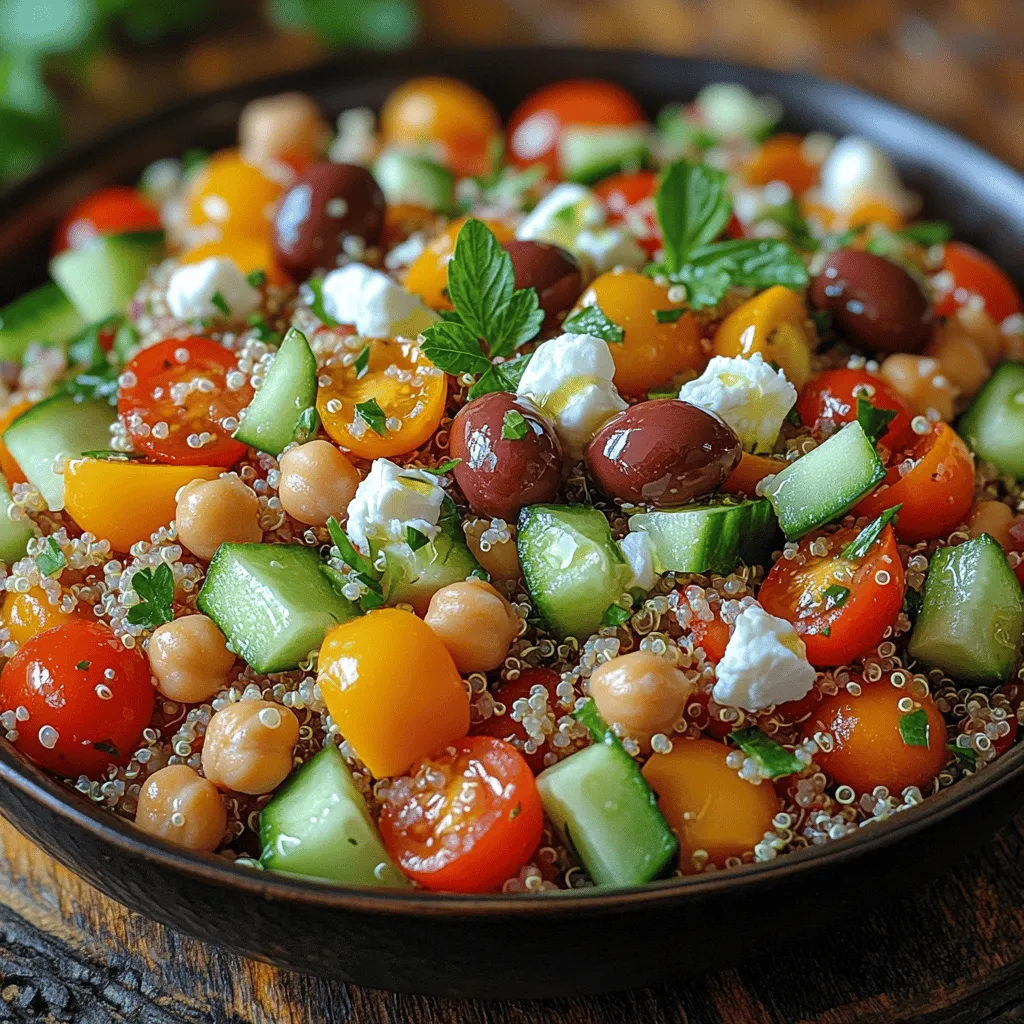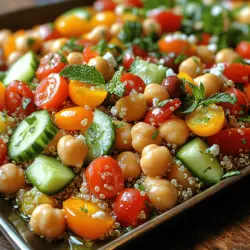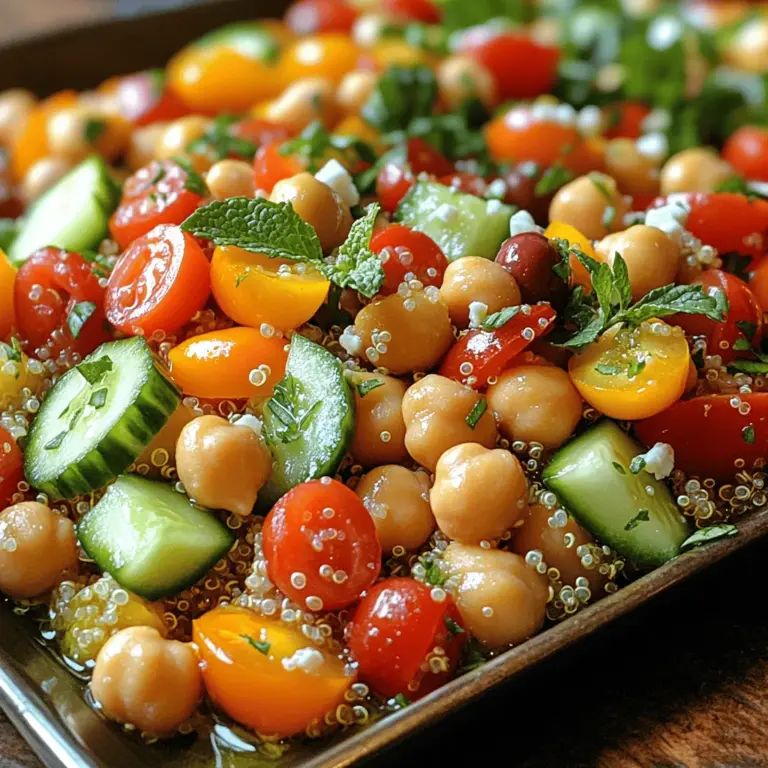Mediterranean Quinoa Chickpea Salad: A Nutritional Gem
The Mediterranean diet has garnered widespread acclaim for its emphasis on whole foods, fresh ingredients, and healthy fats. Rooted in the traditional eating habits of countries bordering the Mediterranean Sea, this diet is not only delicious but is also linked to numerous health benefits, including improved heart health, enhanced cognitive function, and reduced inflammation. One of the standout dishes that encapsulates the essence of the Mediterranean diet is the Mediterranean Quinoa Chickpea Salad. This vibrant and nutrient-dense salad combines wholesome ingredients that cater to a variety of dietary preferences, making it an excellent choice for anyone looking to incorporate more healthy meals into their routine.
The Mediterranean Quinoa Chickpea Salad is a perfect blend of flavors and textures that celebrates fresh produce while providing a hearty dose of plant-based protein. It is ideal for vegans, vegetarians, and those following gluten-free diets, making it a versatile dish that can be enjoyed by many. The combination of quinoa and chickpeas not only delivers a satisfying crunch but also a wealth of nutrients that are essential for maintaining a healthy lifestyle.
One of the key aspects that elevates this salad is the use of fresh ingredients. Fresh vegetables not only enhance the flavor profile but also contribute essential vitamins and minerals that support overall health. The colors of the vegetables bring an appealing aesthetic to the dish, making it a feast for the eyes as well as the palate. In the following sections, we will explore the key ingredients that make up this salad and walk through the initial steps of preparation.
Understanding the Key Ingredients
Quinoa: A Superfood Staple
Quinoa, often referred to as a superfood, is a gluten-free grain that is packed with nutrients. It is a complete protein, meaning it contains all nine essential amino acids that the body cannot produce on its own. Additionally, quinoa is rich in fiber, magnesium, and antioxidants, making it an excellent choice for those looking to boost their nutrient intake. When preparing quinoa, it’s essential to rinse it under cold water before cooking. This process removes its natural coating, called saponin, which can impart a bitter flavor. Cooking quinoa is straightforward; it typically requires a ratio of 2:1 water to quinoa, although using vegetable broth instead of water can enhance its flavor profile significantly. Once cooked, allow the quinoa to cool before adding it to the salad for optimal texture.
Chickpeas: The Heart of Plant-Based Nutrition
Chickpeas, also known as garbanzo beans, are another cornerstone ingredient of this salad. They are an excellent source of plant-based protein, fiber, and several key nutrients, including iron and folate. Chickpeas play a vital role in plant-based diets, providing a satisfying and nutritious alternative to meat. Their creamy texture and nutty flavor complement the other ingredients in the salad beautifully. When using canned chickpeas, it is advisable to rinse and drain them to reduce sodium content and enhance their flavor.
Fresh Vegetables: A Colorful Nutritional Powerhouse
Incorporating a variety of fresh vegetables not only adds color and vibrancy to the Mediterranean Quinoa Chickpea Salad but also maximizes its nutritional benefits.
– Cherry Tomatoes: These bite-sized gems are rich in antioxidants, particularly lycopene, which has been linked to numerous health benefits, including reduced risk of heart disease. Their natural sweetness adds a delightful burst of flavor.
– Cucumber: Known for its high water content, cucumbers are excellent for hydration and provide a refreshing crunch to the salad. They are low in calories and can help maintain a healthy weight.
– Red Bell Pepper: Packed with vitamin C, red bell peppers not only enhance the salad’s color but also contribute to immune health and skin vitality. Their sweet and crunchy texture provides a satisfying contrast to the other ingredients.
– Red Onion: This flavor powerhouse is not only a key flavor enhancer but also contains antioxidants and compounds that promote heart health. Red onions add a slight bite to the salad, balancing the sweetness of the other vegetables.
– Kalamata Olives: These briny, flavorful olives add a Mediterranean touch to the salad while providing heart-healthy monounsaturated fats. Their rich flavor profile enhances the overall taste experience.
– Fresh Herbs: Fresh parsley and mint are essential for adding brightness and freshness to the salad. These herbs not only boost the flavor but also introduce additional nutrients, making the salad even more healthful.
Optional Feta Cheese: A Creamy Addition
While feta cheese is often included in Mediterranean salads for its creamy texture and tangy flavor, it is important to note that it is entirely optional. For those adhering to a vegan diet or looking to reduce dairy intake, the salad remains delicious without it. However, if you choose to add feta, it contributes calcium and protein, enriching the nutritional profile of the dish.
Step-by-Step Preparation
Now that we understand the key ingredients, let’s dive into the initial steps for preparing the Mediterranean Quinoa Chickpea Salad.
Cooking the Quinoa
1. Rinse the Quinoa: Start by measuring out the desired amount of quinoa, typically about one cup for a generous salad serving. Place it in a fine-mesh strainer and rinse thoroughly under cold water. This step is crucial as it helps eliminate any bitterness associated with the saponin coating.
2. Cooking Method: In a medium saucepan, combine the rinsed quinoa with two cups of water or vegetable broth for added flavor. Bring the mixture to a boil over medium-high heat.
3. Simmer: Once boiling, reduce the heat to low, cover the saucepan, and let the quinoa simmer for about 15 minutes, or until all the liquid is absorbed. You’ll know it’s done when the quinoa grains appear to have “popped,” revealing their germ.
4. Cooling Tips: After cooking, remove the saucepan from heat and let it sit, covered, for about 5 minutes. Then, fluff the quinoa with a fork and spread it out on a baking sheet to cool. This step prevents the quinoa from clumping together and ensures a light, airy texture in your salad.
Preparing the Dressing
The dressing is a crucial component of the Mediterranean Quinoa Chickpea Salad, as it ties all the flavors together. A simple yet flavorful dressing typically includes olive oil, lemon juice, garlic, salt, and pepper.
1. Ingredients: Gather the dressing ingredients:
– Extra virgin olive oil for healthy fats
– Fresh lemon juice for acidity and brightness
– Minced garlic for an aromatic punch
– Salt and pepper to taste
2. Whisking Technique: In a small bowl, combine the olive oil, lemon juice, minced garlic, salt, and pepper. Whisk vigorously until the dressing is well-emulsified and slightly thickened. This technique ensures that the ingredients are evenly distributed, enhancing the overall flavor of the salad.
With the quinoa cooked and cooled, and the dressing prepared, you are well on your way to creating a Mediterranean Quinoa Chickpea Salad that is not only delicious but also packed with nutrients. In the following sections, we will explore how to combine these ingredients and assemble the salad for a delightful dining experience.

Combining the Salad Ingredients
Once you have prepared your quinoa and chickpeas, it’s time to combine all the salad ingredients. Begin by placing the cooked and cooled quinoa in a large mixing bowl. The fluffy texture of quinoa acts as a perfect base for your salad, providing both substance and a nutty flavor.
Next, add the chickpeas. Whether you used canned or cooked your own, make sure they are drained and rinsed thoroughly to remove excess sodium and starch. Incorporating chickpeas not only boosts the protein content but also adds a delightful creaminess to the overall texture.
Now, it’s time to add the colorful array of vegetables! Dice the cucumber, halve the cherry tomatoes, and finely chop the red onion and bell pepper. Each of these ingredients contributes a unique crunch and fresh flavor profile that elevates the salad. When combining the vegetables, ensure that they are evenly distributed throughout the quinoa and chickpeas. This ensures every bite bursts with flavor.
Texture and Flavor Balance in the Salad
A well-balanced salad should feature a variety of textures and flavors. The chewiness of quinoa combined with the creaminess of chickpeas sets a hearty foundation. Fresh vegetables like cucumbers and bell peppers introduce a satisfying crunch, while the sweet burst of cherry tomatoes adds juiciness.
Consider adding a handful of olives for a briny kick, or perhaps some diced avocado for creaminess. Each additional ingredient not only enhances the flavor but also contributes to the overall harmony of the dish. Balancing flavors is essential; if your salad leans too heavily toward one flavor profile, consider incorporating additional herbs or a squeeze of lemon juice to brighten it up.
Techniques for Chopping Vegetables to Ensure Even Distribution
To achieve an evenly mixed salad, chopping techniques are key. Use a sharp knife and a cutting board to ensure clean cuts. For vegetables like cucumbers and bell peppers, cut them into uniform pieces—aim for about ½-inch cubes. This uniformity allows for a consistent bite and helps each ingredient shine through.
When chopping herbs such as parsley or mint, use a rocking motion with your knife to finely mince them. This technique releases essential oils and enhances the flavor. Adding herbs at the end will provide a fresh, aromatic finish to your salad.
Dressing the Salad
A delicious dressing can elevate your Mediterranean quinoa chickpea salad from good to outstanding. A simple dressing can be made using olive oil, lemon juice, garlic, and a touch of salt and pepper. Combine these ingredients in a small bowl or jar, then whisk or shake until emulsified.
Importance of Timing: When to Dress the Salad for Optimal Flavor
Timing is crucial when it comes to dressing your salad. If you dress the salad too early, the ingredients may become soggy, losing their desired texture. Ideally, you should dress the salad just before serving. This timing allows the flavors to meld without compromising the freshness of the vegetables.
If you’re preparing the salad in advance, consider keeping the dressing separate until you are ready to serve. This way, the salad retains its crunch, and the flavors can develop in their own time.
Gentle Tossing to Preserve the Integrity of Ingredients
Once your salad is dressed, it’s time to combine everything for the final mix. Use a large spoon or spatula to gently toss the ingredients. Be careful not to overmix, as you want to preserve the integrity of the vegetables without turning them into mush. A gentle folding motion will help distribute the dressing evenly while keeping the salad components intact.
Optional Feta Addition
If you’re looking to add a touch of creaminess and a tangy flavor, consider incorporating feta cheese into your salad. Feta is a staple in Mediterranean cuisine and works beautifully with the other ingredients.
How to Incorporate Feta Without Overpowering the Salad
To add feta without overwhelming the other flavors, crumble it into small pieces. Start with a moderate amount—about ¼ to ½ cup—depending on your taste preference. Gently fold the crumbled feta into the salad after dressing it to ensure it distributes evenly. This way, every bite will have a hint of that creamy, salty goodness without overpowering the fresh ingredients.
Flavor Development and Serving Suggestions
Chilling the Salad
Once your Mediterranean quinoa chickpea salad is mixed, let it chill in the refrigerator for at least 30 minutes. Chilling allows the flavors to meld beautifully, creating a more cohesive dish.
Benefits of Chilling for Flavor Melding
Cold salads often taste better after they’ve had time to sit, as the ingredients have a chance to mingle. The chilling process enhances the overall flavor, allowing the dressing to penetrate the quinoa and chickpeas, making each bite taste more vibrant and refreshing.
Suggested Chilling Times for Optimal Taste
For optimal flavor, aim to chill your salad for about 1 to 2 hours. If time allows, preparing it the night before can be even better, as the flavors will develop and deepen overnight.
Presentation Ideas
Presentation is key to making your dish appealing. While serving in individual bowls gives a personal touch, consider serving the salad on a large platter for a family-style meal.
Serving in Bowls vs. Platters
Using bowls allows for easy portioning and is ideal for smaller gatherings, while a platter encourages sharing and can make for a stunning centerpiece at larger gatherings.
Garnishing with Additional Herbs or Lemon Wedges for Visual Appeal
To elevate the presentation, garnish the salad with additional fresh herbs, such as parsley or mint, and lemon wedges. This not only adds a pop of color but also invites guests to squeeze fresh lemon juice over their servings for an extra zesty kick.
Pairing Suggestions
To round out your Mediterranean meal, consider serving your salad alongside grilled chicken, lamb skewers, or roasted vegetables for a complete dining experience. This salad pairs wonderfully with pita bread and hummus, making it ideal for a Mediterranean-inspired feast.
Complementary Dishes for a Complete Meal Experience
Opt for lighter protein options like grilled fish or shrimp, which complement the salad’s flavors wonderfully. You could also serve it with a side of tzatziki or a warm, crusty baguette to soak up the dressing.
Beverage Pairings that Enhance the Mediterranean Theme
When it comes to beverages, serve the salad with a glass of chilled white wine, such as Sauvignon Blanc or a crisp rosé. For non-alcoholic options, consider sparkling water with a slice of lemon or a refreshing iced tea infused with mint.
Nutritional Analysis
Breakdown of Macronutrients in the Salad
This Mediterranean quinoa chickpea salad is not only delicious; it is also packed with nutrients. The quinoa provides a good source of complete protein and complex carbohydrates, while chickpeas add additional protein and fiber. The vegetables contribute essential vitamins and minerals, making this salad a nutritious choice.
A single serving of this salad typically contains:
– Calories: Approximately 350
– Protein: 15 grams
– Carbohydrates: 45 grams
– Fat: 12 grams
– Fiber: 10 grams
Health Benefits of the Mediterranean Diet Supported by the Ingredients
The Mediterranean diet is renowned for its health benefits, including reducing the risk of chronic diseases and promoting heart health. The ingredients in this salad—rich in healthy fats, fiber, and antioxidants—contribute to overall well-being. Furthermore, the emphasis on plant-based foods supports a balanced diet that can aid in weight management and energy levels.
Discussion on Plant-Based Eating and Its Positive Impact on Health
Incorporating more plant-based meals into your diet can yield numerous health benefits, including improved digestion, reduced inflammation, and enhanced mood. This salad is a perfect example of how delicious and satisfying plant-based eating can be without sacrificing flavor or enjoyment.
Conclusion
The Mediterranean quinoa chickpea salad is not only a feast for the eyes but also a nourishing and satisfying meal. By utilizing fresh, wholesome ingredients, this salad embraces the essence of the Mediterranean diet, promoting health and vitality.
As you prepare this salad, remember that it’s versatile; feel free to experiment with different vegetables, herbs, or proteins to make it your own. The beauty of this dish lies in its adaptability.
Incorporating fresh ingredients into your daily meals can transform your eating habits, making it easier to enjoy nutritious and delicious food. So, whether you’re sharing it at a gathering or enjoying it as a meal prep option during the week, this Mediterranean quinoa chickpea salad promises to deliver flavor, nutrition, and satisfaction in every bite. Enjoy exploring the vibrant world of Mediterranean cuisine!

